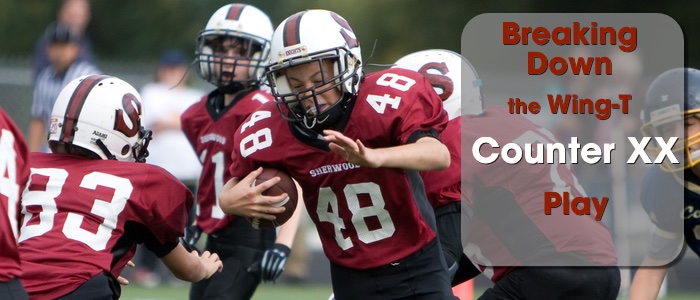Breaking Down the Wing-T Counter Criss-Cross (XX) Play

A coach recently asked me to explain the backfield footwork for the Counter Criss-Cross (aka Counter XX) play, a staple play in most Wing-T playbooks. I’m going to share more than that and give a detailed explanation of the play along with some variant ideas.
In youth football, I typically run the Counter XX as a double handoff counter play with backfield flow similar to the Power Sweep. From the Right formation the QB steps directly to the left halfback and hands off to him, then continues upfield to help lead block. The halfback gets to fullback depth then runs flat and takes the ball from the QB in his palms. He does not tuck the ball. He then gives the ball to the right wingback on an inside handoff then continues his fake sweep. The wingback steps flat to the left and takes the handoff from the halfback with his left arm up then cuts up off the right guard kick-out block.

You can also run this from the Rose formation (double wing) and simply alter the path of the left wingback to make sure he gets enough depth to finish the inside handoff.
The play-side linemen all have the same rule: block down to the next gap in. The back-side (right) guard pulls and gets enough depth as he crosses the center to find his kick-out block, which will likely be immediately outside the left tackle. The right tackle reaches left to the back-side B gap and pinches with the center to ensure no penetration. This may require Gap blocking technique by the center and/or the right tackle. The tight end pulls flat down the line and turns upfield as he crosses the left tackle to lead block.
Timing is key for the backfield as this is a slow developing play. The ball carrier (wingback taking the second handoff) will need to delay before starting his running path. You have a few options here:
- Jab and step down like he will be blocking for Power Sweep, then cut back in
- Open up with his inside foot and pause for a count, squaring his shoulders to face the other sideline.
- Just sit and wait for a count (“1 Mississippi” etc.)
I like to keep the ball carrier path tight to the offensive line and right behind the pulling tight end to hide him. This is not a wide sweep and the path will take him just outside the playside guard or tackle. In fact, the running lane should look just like the Wing-T Counter play I’ve talked about previously.
Here’s some more film for review:
Variations
There are many other ways you can run the backfield motion without changing the blocking scheme. Here are some ideas:
- Run “Jet Counter XX” and instead of the first ball carrier showing Power Sweep, put him in jet motion and show jet sweep with the first handoff. The second handoff will be outside instead of inside, and you’ll teach the ball carrier to turn upfield hard just like he would on Buck Sweep.
- Run this as a counter off Buck Sweep and fake trap with the fullback first. I think this variant can slow the play down even more, but if you are having success with the Buck Series this can be a great counter play.